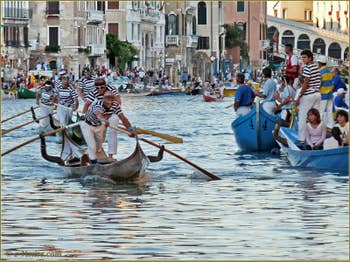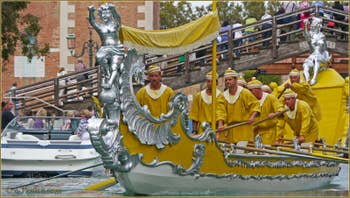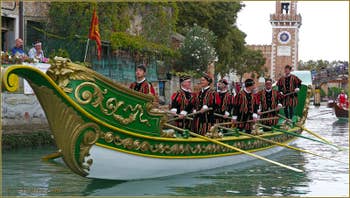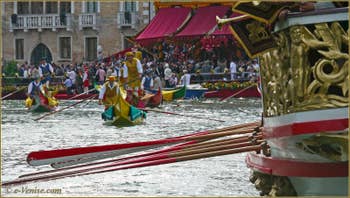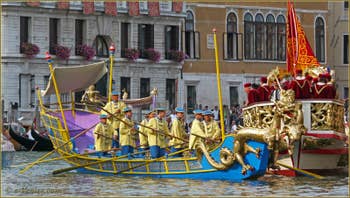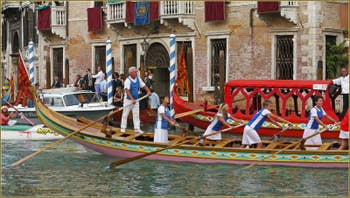What's On Celebrations | Exhibitions | Biennale | Mostra Cinema
Celebrations Historical Regatta | Redentore | Salute | Vogalonga | Marathon | Marys | St Martin
The Regata Storica or Historic Venice Regatta
Date of the Regata Storica 2026
The next Regata Storica in Venice will be held on September 6, 2026.Visits Doge's | St.Mark | Gourmets | Museums | Venice | Murano Burano | Gondola | Cruises
The 2026 Historic Regatta programme
15:30: Historic and Sporting ParadeParade along the Grand Canal of historic boats with costumed characters, gondolas and traditional boats from the Venetian Voga alla Veneta associations.
Itinerary: St. Mark's Basin, St. Mark's Canal, Rialto, Railway Station and return along the Grand Canal to Ca' Foscari.
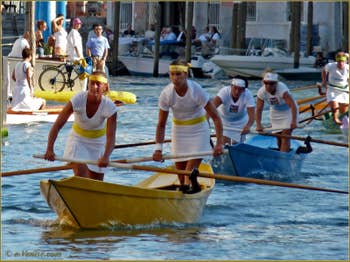
Women's Race on Masacareta 4:00pm: Regatta on Mascarete with two rowers from the Maciarele and Schie.
Categories: Maciarele Senior (up to 14 years old). Itinerary: from Punta della Dogana to Ca' Foscari, Schie (up to 10 years old). Itinerary: from Rialto to Ca' Foscari, Maciarele Junior (up to 12 years). Itinerary: from San Stae to Ca' Foscari
4.30pm: Giovannissime, young women regatta on Pupparini with two rowers
Itinerary: Basin of St. Mark, Grand Canal, visit to the paleto of Ca' Farsetti and arrival at Ca' Foscari.
4.50pm: Giovannissimi regatta on Pupparini with two rowers
Itinerary: Basin of St. Mark, Grand Canal, visit to the paleto of Ca' Farsetti and arrival at Ca' Foscari.
5.10pm: Caorline regatta with six rowers
Itinerary: St. Mark's Basin, St. Mark's Grand Canal, Rialto, turn around the Paleto at San Marcuola, return via the Grand Canal and arrival at Ca' Foscari.
International university rowing regatta on 8-oared galleys between the Ca' Foscari/IUAV University of Venice crew and crews from other universities. After the Caorline regatta (for 3rd and 4th place) and after the gondolini regatta (for the final). Route: from Rialto to Ca' Foscari.
5:40pm: Women's regatta on Mascarete with two female rowers.
Itinerary: Basin of St. Mark, St. Mark's Canal, Rialto, turn around the Paleto at San Marcuola, return via the Grand Canal and arrival at Ca' Foscari.
6:10pm: Gondolini regatta with two rowers.
Itinerary: Basin of St. Mark, Grand Canal, Rialto turn around the Paleto at San Marcuola, return via the Grand Canal and arrival at Ca' Foscari.
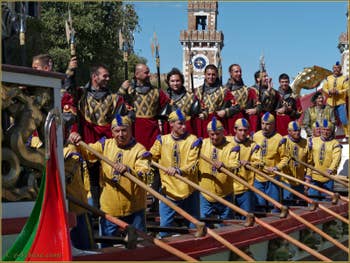
The flagship: the Serenissima The Regata Storica is undoubtedly one of Venice's most popular annual events, and this is true both for tourists and for the Venetians themselves, who prepare for it long weeks in advance, feverishly following the heats right up to the big day, the first Sunday in September each year.
The day of the historic Regatta is in fact the day of the "final", where only the best rowers in each category are present.
Venice invented the regatta, the perfect symbol of its status as a city built on water.
And, as with the word "Arsenal", also born in Venice and adopted by dozens of countries, the Venetian word "Regata" has enjoyed the same international success: in French (régate) in English (regatta), in German (regatta) or even in Spanish (regata).
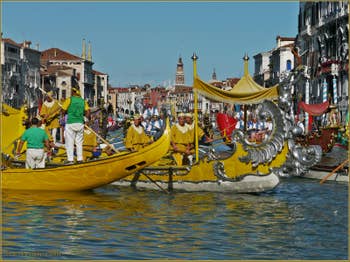
The Historic Procession The origin of the word "regata", however, is uncertain.
According to Guiseppe Tassini, the word regata is said to come from "riga", the line. As such, it is worth noting that at the start, the boats were lined up behind a rope, the "spagheto", which was then released into the water to let the boats pass.
The word "riga" therefore brings to mind the row of boats. And all the more so, because in Italian, the word for row is also riga.
Giuseppe Tassini also suggests as its origin the word auriga, a word of Roman origin and which corresponds in French to the word Aurige, the "charioteer" in ancient Greece and Rome, including the famous Aurige of Delphi.
But the latter explanation is considered by Tassini himself to be the least likely.

The boats of the Historic Procession. Finally, you should also know that in Italian, "rigare", means to furrow.
And as the Venetian has the habit of condensing, modifying, accommodating words to his own sauce, (for example the church San Giovanni e Paolo became for the Venetians: Zanipolo!) it is therefore quite possible that "regata" could also be, in our opinion, a condensation of riga and rigata.
This, moreover, is also the thesis held by Giustina Renier-Michiel, author of the book "Origine delle Feste Veneziane", who states that at the origin of the " Challenge", of the first regatta, the Government of the Republic had decided to start the boats in a line, (in "riga") and that this is indeed where the word "Regata" would come from.
The motivation of the Government of the Republic of Venice when the first regattas were made official was that it saw them as an excellent means of training and maintaining the qualities of its rowers.
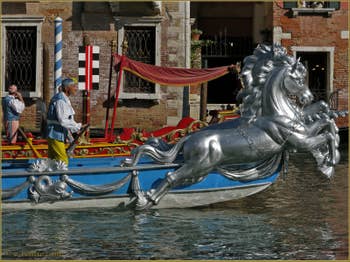
The boats of the Historic Procession. Let's not forget that at the time, namely in the 13th century, the Venetian commercial or military navy was more rowing than sailing, even though sails, which had not yet been perfected, were also used.
The advantage of using galleys or boats that used sails and oarsmen was also that they could engage in combat or simply continue their course even when the wind failed.
Transforming military training into a "game", a challenge, is in fact quite analogous to the knights' tournaments that existed in most other European countries.
It was also a skilful way of channelling sometimes overflowing energies, which could find an outlet in regattas in times of peace!
The Regata Storica, Venetian Olympic Games and the splendours of yesteryear
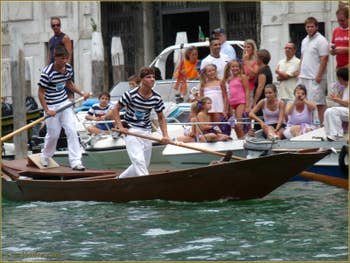
The Historic Venice Family Regatta from youngest to oldest. The other interest and great success of the Venetian Regattas was that they excited the most popular sections of the population just as much as the nobles themselves.
A sort of circus games, the Venetian maritime Olympics, the regattas quickly became one of the major events in Venetian life.
And such was their success that to the regattas known as "challenge", regattas known as "parade" began to be added, to celebrate an exceptional event or welcome a distinguished guest, such as the regatta attended by Henri III, King of France, in 1574.
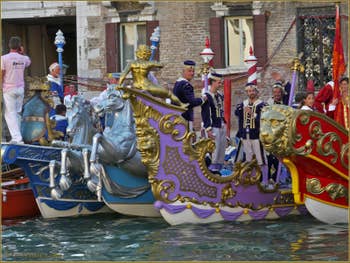
Historic procession And these first parade regattas, preludes to today's Régate Historique, intelligently blending pomp and sporting jousting, were also a tremendous success, a success that continues to this day, nine centuries later!
Here, in addition to that of the King Henry III, are some other official Regattas that were given by the Republic of Venice to honour its distinguished visitors:
- In 1451, in honour of emperor Frederick III,
- In 1493, in honour of Beatrice d'Este, wife of the Duke of Milan, Lodovico Sforza,
- In 1686, for the Duke of Brunswick, Ernest Augustus,
- In 1740, for Frédéric Chrétien, son of Frédéric Auguste III, King of Poland and Elector of Saxony,
- In 1764 for Edward Augustus, Duke of York,
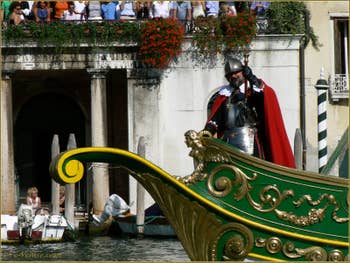
General Da Mar - In 1775 to honour the Emperor Joseph II, and his brother the Archduke,
- In 1782 at last (Napoleon Bonaparte having put an end to it all in 1797.... ) for the Emperor Paul of Russia, son of the Tsarina Catherine of Russia, and his wife, Marie Sophie Dorothée, Princess of Württemberg, who had travelled to Venice under the name of "Contes du Nord".
But the sporting side was not put on the back burner and, not only were the first boats, which could have 30 to 50 rowers (given that originally it was mainly about "training" rowers for the Republic) replaced by smaller boats, allowing in addition to create several distinct competitions within each Regatta and also give more spice to the races.
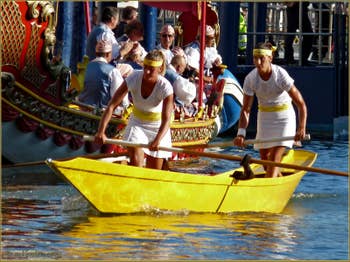
The Mascarete with two rowers Women's crews also appeared, as early as 1493, the date of the first women's regatta.
Further proof of the very open nature of Venetian society even then.
The fall of the Republic in 1797, followed by the Austrian occupation, put an end to the official regattas for several years, but they resumed, at the request of the Municipality of Venice, and with the agreement of the Austrian occupiers, in 1825.
The Historic Regatta, the Regata Storica, which you can attend every year, is therefore much more than just a parade of boats and races, here it is a true reminder of Venice's past glory as well as the major sporting event of the year for Venetians.
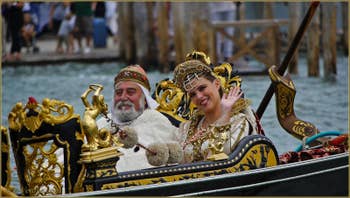
Il Doge and Catarina Corner, Queen of Cyprus It was both touching and amusing to hear old Venetians last Sunday passionately shouting "Il Doge! Il Doge! Viva Il Doge!" as the official gondola passed, in which a superb bearded Doge, accompanied by the Queen of Cyprus, Catarina Corner, brought the Serenissima to life, as if it were all still very much alive.
And precisely, if the Regata Storica is still so successful, it's because in the soul of every Venetian still lives that splendid past, that pride in being Venetian, in having been one of the most powerful countries in the world for several centuries.
A whole nation sings and shouts "Forza! Forza!" to the rowers as they cheer them on, a whole nation that still identifies fully with its city and its love of the beautiful game.
Venetian Historical Regatta, Popular Festival and Vocabulary
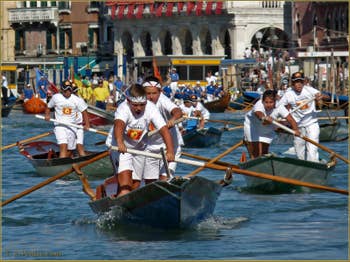
All ages represented This fervour, which is both popular and shared by all the patricians, is not just the preserve of the oldest; you only have to look at the competitions dedicated to the youngest, including the boats for the under 14s, to understand that the torch is still held high: here we row "standing" and for a long time to come.
Because that's the great special feature of this Regata Storica, which you won't be able to see anywhere else in the world, here we actually row standing up, and to move our boat forward we "push" on the oar instead of "pulling", as in rowing for example.
In fact, it's the whole body that is put to work, legs, arms, back... and rowers find themselves practically lying on their oar at the end of the movement.
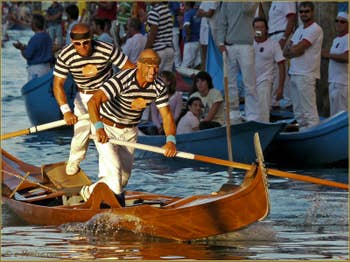
Gondolini Race This "Venetian-style rowing", which is particularly well-suited to the city's narrow canals, and allows a single oar to be used for the same reasons, is particularly athletic and on Sunday you only had to see the effort on the faces to understand just how gruelling this sport is and appreciate the high level of these athletes.
The course of the Historic Venice Regatta
The race starts at the very end of Castello, in the Giardini Napoleone, where the Biennale is held.From there, the competitors head up the Grand Canal, to just before the Rialto for the younger ones, where they turn around, to cross the finish line at the Ca' Foscari, just before the Accademia bridge.
The women, competing on the two-oared mascarete, turn back at the church of San Marcuola.
The other men's races, the six-oared Caorline and the two-oared Gondolini, which also start from the Giardini Napoleone, make a U-turn at Santa Lucia station and then cross the finish line at Ca' Foscari.
Vocabulary: Start, Turn and Finish Line

The Caorline race At the start, and the technique has been the same since the origin of the Regata Storica in the 13th century, the competitors stand in front of a rope stretched across the entire width of the starting line to which ropes approximately two metres long are attached and terminated by a handle, the "spagheto".
It is the poppiere, the stern sailor, who holds the spagheto and releases it when the starting signal is given. In this way, the boats are perfectly aligned at the same height for the start.
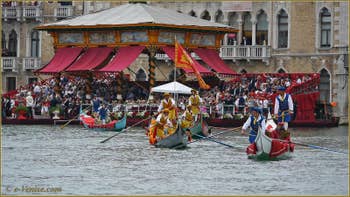
The "Machina" The pole around which competitors must turn is called the "paleto".
Finally, the finishing line is symbolised by the "machina", a wooden construction, with engraved panels, covered in gold and in bright colours, all on a floating pontoon on the bend in the Grand Canal, just opposite the Ca' Foscari.
This is the place to be for VIPs, official guests of the City of Venice and other important people.
Comtesse des Ursins - The Regata of the Northern Counts in Venice in 1782
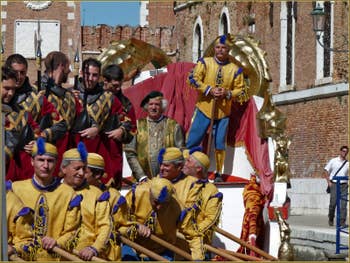
The Serenissima in front of the Arsenale The “Northern Counts” were the name used to travel incognito in Europe of Tsarevich Paul Petrovich, son of Catherine II the Great, Empress of Russia and his wife Zarevna Maria Feodorovna.
These “Northern Counts” who attended the historic regatta in Venice in 1782 were in fact the future Emperor of Russia, Paul I and the Impress Maria Feodorovna, whose maiden name was Sophie Dorothea of Württemberg.
"Never had the sun shown more brilliance than on that day: Its beneficent warmth softened the weather to such an extent that one could hold one's place at the windows and on the Grand Canal without suffering the slightest discomfort.
This Canal, always striking for the singularity and beauty of the buildings lining it, was lined with innumerable spectators on all sorts of boats and gondolas, stationed to follow and admire the race.
All the houses were adorned with rich carpets, which hung from every window, and these windows were garnished with the most beautiful people.
Only two races had been allowed, instead of the usual four, because of the season: the first, of single-oar gondolas, and the other, of double-oar gondolas.
Gondolini Regatta These are very small boats that are so called because they have that sharp, jagged iron at the bow that arms the large gondolas.
The smallness of these boats is such that it takes all the skill of the oarsman, and all the intelligence of balance not to tip over.
From distance to distance, on both banks of the Canal, small amphitheatres and wooden terraces had been erected, where there were bands of instruments, whose harmonic noise dominated from time to time over the hum of an entire People.
The whole morning was filled with the amusement of the sight of all that went up and down the Canal: the variety of the decorations, the buffoonish gaiety of the Venetian Carnival, the beauty of the scene where all this took place, struck the imagination, and even carried to the heart by all the reflections, which such an aspect was entitled to excite.
It was not until about one o'clock in the afternoon that eight and six-oared boats appeared, called Biscione and Malgherotte, belonging to the Lords who were doing the honours of the City for the Princes, and to the other Cavaliers, who wanted to distinguish themselves by the desire to do honour to the Homeland and give the festival a more triumphal and magnificent air.
Historic procession Indeed nothing better heard, nor more elegant, than this aquatic decoration.
Gold, silver, fabrics, feathers, flowers are the material, that some happy and timely idea, shapes and puts in the most beautiful day.
The owner of each ship stands with a friend, on cushions at the bow, kneeling, a way of being appropriate to this function: For each Rider is armed with a bow, with which he shoots small golden or silver balls, to keep any other boat away from the Great Waterway at the time of the Race, and thereby protect the Race itself.
Two superb Péottes, another very convenient building, where you can sit and lock yourself in, as if in a cabinet, were prepared for LL. AA. II (Counts of the North).
In each one eight very richly dressed rowers, some in pink, flowers, and silver, the others in blue, pink, and silver, surrounded the two partitions intended for the Princes, and closed only by four large crystal sides, so that nothing could steal their sight from any part.
The historic procession All around the satin finished with silver fringes and hoopoes insulted the wave and dipped in its agitated surface.
In the midst of the procession of these Péottes, and about twenty other decorated buildings, the jousters were led before the windows of the Counts of the North, who were preparing to compete for the honours of the day, as if to pay tribute to them for this festival, and for all the care that had been taken to make it a success.
This tribute was paid, and the Bisciones, who were in the presence of the Counts of the North, took their places. Once this tribute had been paid, the Biscione and the Malgherotte accompanied the combatants to the place where the race was to begin, and prepared to protect the safety of everyone and the freedom of the Canal.
When the signal was given, LL. AA. II. did Messrs Pesaro and Grimani the honour of keeping them to dine with them, climbed into the Peottes, ran along part of the Canal to enjoy the beauty of the spectacle put on by the Spectators, and took their places close to the end of the race to judge for themselves the merit of the heroes of the Regata.
The Machina, official stand This area was also decorated in very good taste: in the shape of a Temple rising out of the water, at the foot of which, among the rocks, sprang a hundred small jets of water, which not only served to embellish the idea, but at the same time prevented the spectator boats from getting too close to the Machine, disturbing the effect in perspective, and making it difficult for the jousters to access.
A large and beautiful
A large and beautiful vault under the Temple opened the way to the Canal, and presented the four flags, ready to be snatched by the victorious hands of the first who had the good fortune to enter: the colours distinguished their order and merit.
The Biscione and the Malgherotte, splitting the waters with the speed that is typical of their construction, brought the combatants to the end, among which the first four crowned themselves, displaying on their victorious canoes the honourable mark of their valour, amid the noisy acclamations of a People beside themselves with the joy inspired by this day.
Dragon in the historic procession LL. AA, II. stood during the last term of the Race on the prow of their Peotte, and appeared animated by the interest of the moment, in a manner most touching to the patriotic spectators.
The victors, as they paid homage to them from the Victory Pavilion, received from their August hands rewards, and praise, which flattered these good people even more.
It was noted that Monsieur le Comte du Nord was generous to one of the players, who had had the misfortune to fall into the sea, very close to the goal, which he had missed.
This trait of sensitivity on the part of the Prince was reported and received with the most universal satisfaction.
The sports procession The Counts of the North went to observe the second Regata from House Mocenigo, which is situated opposite the end of the Race, and found a chosen Company in this Palace.
This day in fact fulfilled the idea that the August Travellers had had of a Regata.
It succeeded marvellously: they never ceased to praise its singularity, which charmed the Venetians who saw that their ideas were captured in their true perspective; namely, to give the illustrious Guests, who honoured them with their presence, all the national marks of their satisfaction.
We never explain ourselves better, than in our own language, and each Nation has a kind of feast, which is like its own language of solemn hospitality."
Comtesse des Ursins - The Northern Counts' stay in Venice - 1782
Celebrations Historical Regatta | Redentore | Salute | Vogalonga | Marathon | Marys | St Martin
What's On Celebrations | Exhibitions | Biennale | Mostra Cinema
Back to Top of Page


